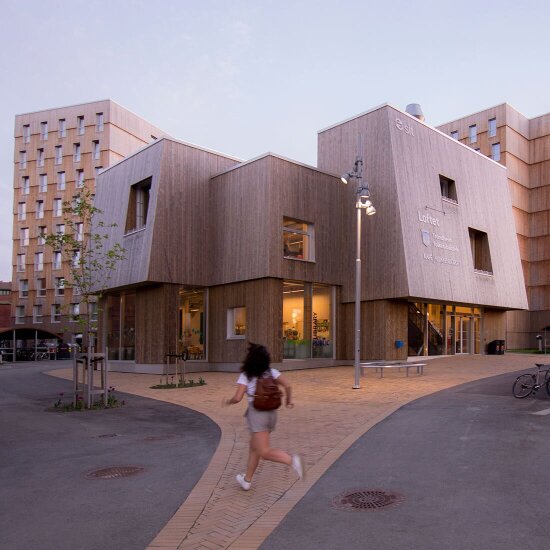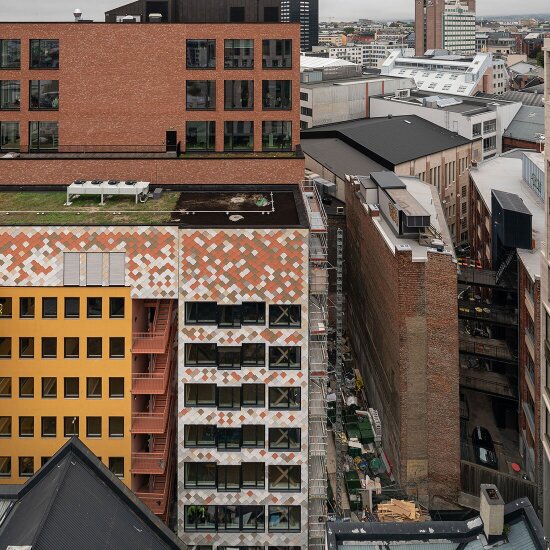The Moholt student village in Trondheim, the Kristian Augusts gate office building in Oslo, and the startup company reMarkable were the winners of the DOGA Honours Award. Minister of Trade and Industry Iselin Nybø presented the award at an event at DOGA in March 2021. She said that the three winning projects give us an exciting glimpse of what will guide Norway in the future.Read more about design and architecture in Norway >>
“They all show the ability to lead the way and inspire others. They are examples of professional quality – they are beautiful, functional and innovative – and add unique value to their surroundings. They demonstrate that design and architecture are worthwhile, and they show the way towards sustainable solutions,” said the Minister.

Photo: Marte Garmann
Tor Inge Hjemdal, CEO of Design and Architecture Norway (DOGA), says that the level of this year’s winners is stratospheric.
“Here we have two incredibly strong and visionary architectural projects that both score highly in sustainability and circular thinking, as well as a design project that puts a Norwegian tablet right up there among the world leaders in consumer electronics. We are talking about three well-deserved winners of these honours”, he said.
Moholt 50|50: Passive house for students built from solid wood
When the student welfare organisation in Gjøvik, Ålesund and Trondheim (Sit) decided to build new student accommodation in Trondheim’s biggest student village, Moholt, they also wanted to establish a new best practice for sustainable student accommodation. They hired MDH Arkitekter, who joined forces with Sit in an interdisciplinary process that has helped to significantly improve the knowledge of Norwegian architects, consultants, contractors and suppliers in building with solid wood.
The result is a student village in which every building is a passive house built from solid wood, with energy supplied by a dedicated local heating plant. Plenty of good meeting venues and minimal use of corridors help to promote a sense of community and social interaction.
Moholt 50|50 was under construction from 2014–2019, and it includes accommodation for 632 students, a kindergarten, activity centre and local library.

Photo: MDH Arkitekter
Commitment to the environment
The panel for the DOGA Award for Design and Architecture praises Moholt 50|50 for the way it impresses in both concept and details.
“It is clear that environmental and social sustainability have been central drivers that influenced the project right down to the level of individual details. A good example of this is how they use architecture to promote a sense of community and combat loneliness. Another example is the clever system of fitted furniture that was built in situ and means that in practice, all students need to bring when they move in is a mattress,” was a comment in the panel’s remarks.
Kristian Augusts gate 13: Circular and ambitious renovation
When the property company Entra bought Kristian Augusts gate 13, a modest office building in Tullinløkka, few could have imagined that this would become a lodestar for the circular building industry of the future. In fact, it had not even been decided whether to keep the building or demolish it.
Entra and the architectural office Mad Architects set ambitious targets for themselves. Could the office building be renovated in accordance with the circular principle, reusing and recycling materials and building components? They were soon joined by Spaces, the international coworking giant, as the tenant and partner, and interior architects from Scenario. A number of other companies were also engaged to turn the project into reality.

Photo: Kyrre Sundal
Materials supplied by buildings in Oslo
It was an enormous job to find suitable materials and bring them together. The old office building and its new extension have been fitted with façade panels from other renovation projects. Concrete slabs were taken from the R4 government building that was demolished in 2019.
Kværnerbyen supplied the windows, which were available due to an ordering error, while grating panels from the old municipal swimming pool at Tøyen in Oslo were given a new life as railings. The project has also rescued and renovated many of the fixtures and fittings from the original building.
Kristian Augusts gate 13 is now regarded as a landmark and a reference project for circular and sustainable building practice. The experience gained here is being used on other projects, and has also been an important part of the work of changing the regulations to make it easier to reuse building materials.
The path of greatest resistance
The panel for the DOGA Award for Design and Architecture says that the project shows what it is possible to achieve once you set yourself ambitious and difficult targets.
“Kristian Augusts gate 13 is being awarded the DOGA Award for Design and Architecture because we need groundbreaking projects like this. We are in no doubt that this project has the potential to change the industry. The developer, architect and consultants are to be highly commended for the work they put in throughout the project. They have chosen the path of greatest resistance and worked doggedly to get this important pioneering project off the ground,” the panel wrote in its remarks.
reMarkable 2: The feeling of paper makes a comeback
reMarkable and the dream of recapturing digital surfaces on behalf of paper was started by Magnus Wanberg in 2013. He soon had a designer and a developer on his team. reMarkable 1 was launched in 2016 and achieved one of the most successful pre-sales campaigns ever from a European start-up company.
Despite the success of that first tablet, the Norwegian start-up company was in no hurry to get new models out onto the market. Instead, reMarkable initiated a very extensive, interdisciplinary development process in which technologists, product designers, interaction designers, engineers, logistics experts, marketing consultants and economists worked together to create an even thinner, faster and simpler version of the tablet that aims to make us all a little smarter and less stressed.
reMarkable 2 was launched in 2020, and has been highlighted by publications including the influential Time Magazine as one of the major innovations of last year.

Photo: Susann Daljord
Human and warm
The panel for the DOGA Award for Design and Architecture praises reMarkable for creating a sophisticated technology product with a warm and human feel.
“The product itself is beautiful and well thought out. A great deal of innovation also lies behind the technical design of the product – from the exact feeling of paper, to the art involved in fitting such advanced technology into the thin shell,” the panel said in its remarks.
No distracting notifications
reMarkable 2 is perfect for anyone who writes something down every day, no matter how much or how little. The tablet recreates the tactile and intuitive experience you get when writing with pen and paper. It converts handwriting to digital text, organises the documents you create and allows you to share them with others. But it does not distract you with notifications and funny noises, allowing you to focus on your work and waste less time on trivialities.
The jury was impressed at how the Norwegian start-up company actually dared to bring its vision to life.
“All the choices they make, from product functions to packaging design and how they approach customers, is in line with the company’s basic values. This has allowed them to create their own universe and a clear identity that really connects with the target group”, the panel wrote.
DOGA Honours Award
The DOGA Honours Award is DOGA’s most prestigious award, and is given to projects of an outstanding design and architectural quality which make a major contribution to improving social, environmental and financial values.